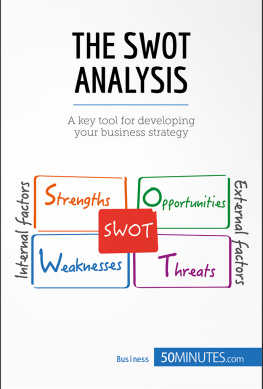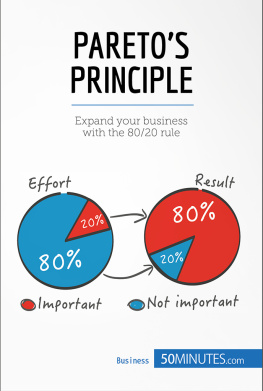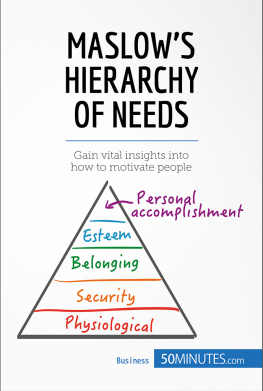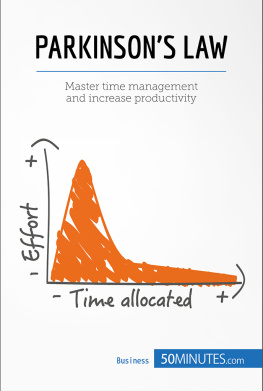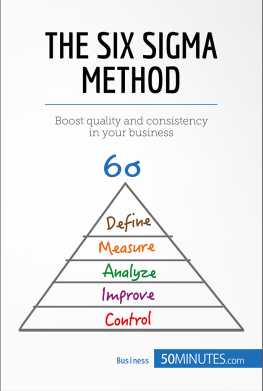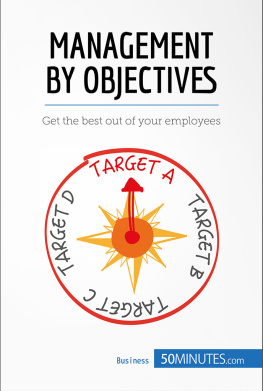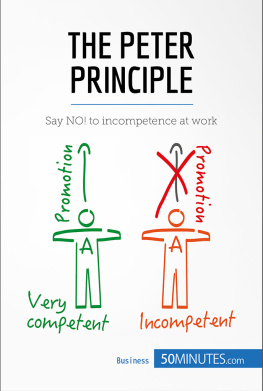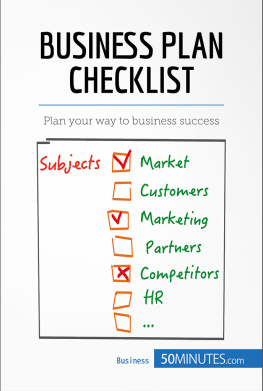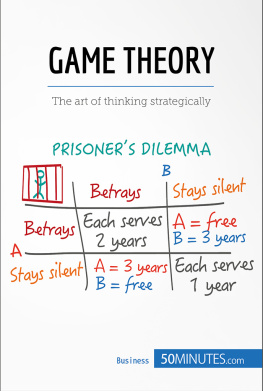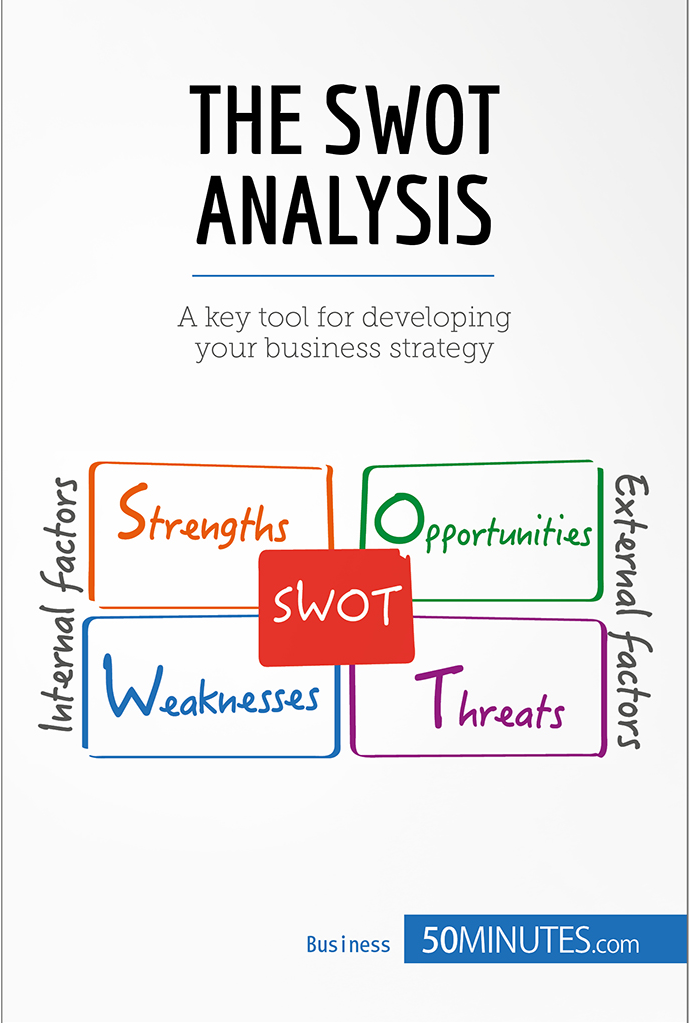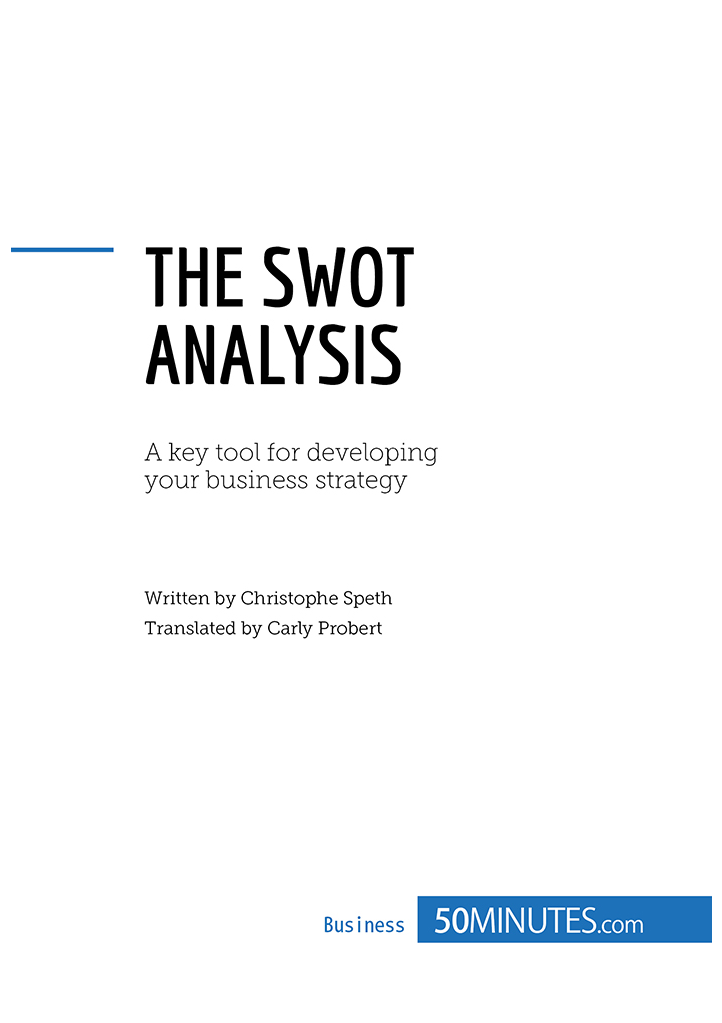The SWOT analysis
Key information
- Name: the SWOT analysis or SWOT method is an acronym of the terms Strengths, Weaknesses, Opportunities and Threats.
- Uses: this model allows organisations (businesses, public administrations or associations) to quickly identify both its internal factors linked to internal functioning and external factors that depend on the environment in which it is evolving. The SWOT analysis is used as a decision-making tool and to facilitate the development of strategic plans.
- Why is it successful? The power of the SWOT analysis lies in its simplicity. As well as being easy to use, it also collects results that can be easily communicated to the public.
- Key words:
- External factor: an element that an organisation cannot influence, linked to the environment in which it evolves.
- Internal factor: an element that can be influenced or modified by the organisation.
- Strengths: internal factors of the business that reinforce its competitive position.
- Weaknesses: internal factors that weaken the competitive position of an organisation.
- Opportunities: external factors that have the power to positively influence the competitive position of an organisation.
- Threats: external factors that negatively influence the external environment of an organisation.
Introduction
History
The SWOT analysis originated from the publication Business Policy: Text and Cases (1965), created by four professors at Harvard University Edmund Philip Learned (1900-1991), Roland Chris Christensen (1919-1999), Kenneth Richmond Andrews (1916-2005) and William D. Guth. This method is one of the first models to consider the external environment of an organisation. Before, strategy models restricted themselves to strategic planning, without taking their environment into account.
Today, the SWOT analysis is mainly used within the marketing departments of large businesses. Many SMBs also use it as a decision-making tool.
A number of consultancy firms also use the SWOT analysis because it allows them to quickly analyse the situation and present it to their clients schematically and more simply. Other companies, such as McKinsey and BCG, have their own analysis models.
Definition
The SWOT analysis is a multidimensional tool for strategic analysis:
- it identifies an organisations internal factors (strengths and weaknesses) and its external factors linked to its environment (weaknesses and threats);
- it also allows organisations to prioritise factors in terms of expected impact, whether they are positive (strengths and opportunities) or negative (weaknesses and threats).
A SWOT analysis has no intrinsic value unless it is used for strategic purposes.
Theory
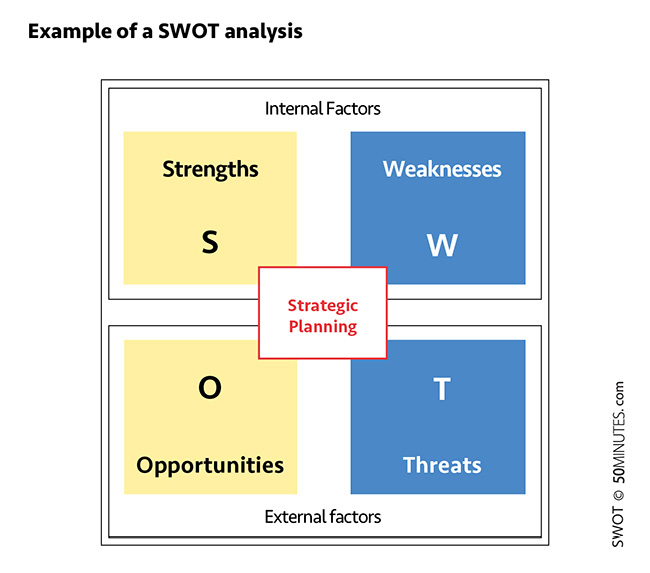
The SWOT analysis investigates the current situation of an organisation at a given time, in a forward-looking manner as opposed to a retrospective one. It also analyses the structure, keeping future prospects in mind. At the same time, the SWOT analysis focuses on the internal functionality (strengths and weaknesses) and on the external environment (opportunities and threats) of an organisation.
- Strengths are elements of an organisation that positively influence its development and its competitive position. In general, strengths are considered to be particularly significant as they do not characterise the competition. The SWOT analysis identifies the competitive advantages held by a company over its competitors.
- Weaknesses are also linked to the internal functioning of an organisation, but they generally have a negative impact on its development and its competitive position. The ability to clearly identify the internal weaknesses of an organisation is vital: it allows for the improvement of relevant issues and the re-orientation of work in order to make them less vulnerable.
- Opportunities for an organisation depend on those available in the external environment. They can be exploited to improve progression and competitive position. Once this is done, they can become forces that positively influence the development of an organisation.
- Threats also originate from the external environment of an organisation. Their identification is often the result of traditional strategic work. As long as they are detected in time, threats can be better anticipated and their impact on performance reduced (and vice versa).
Sometimes, threats can become strengths. Likewise, opportunities can become weaknesses. In fact, given that the organisation does not develop in its environment alone, its future also depends on the decisions made by competitors.
Factors that influence the evolution of an organisation
In terms of internal functioning, many characteristics need to be taken into account in order to identify the strengths and weaknesses of an organisation, including:
- Cost competitiveness . One of the first aspects that make a business competitive is its ability to keep costs low. In order to manage costs, it must closely monitor the efficiency of production technique (is it possible to produce more using less?) as well as the allocation of resources (should it substitute capital for labour?). A conflict can arise between cost-competitiveness and worker protection. For example, if lower social and environmental standards can reduce costs, that does not mean that it does not have a (negative) impact on workers.
- Network and distribution capacity. Does the company structure have an effective distribution network? In particular, does it guarantee a good delivery service (high rate of products that arrive on time, low rate of breakages, low rate of errors, etc.)? Does it succeed in rationalising distribution costs (sufficiently low global costs of storage and transport of merchandise)? A possible compromise between product quality, delivery time and distribution costs is lower stock levels. This strategy is based on the increasing use of new information technology and communication (NICT). Often referred to as just in time production, it means that a company manufactures a product once it is ordered by the customer and is delivered in a very short time due to its effective distribution network.
- Sales and marketing. The marketing department also plays a crucial role in the success of a company. Is it in a position to anticipate customer needs? Is it capable of launching publicity campaigns in order to attract customers? A good marketing strategy is an undeniable force for any company.
- Financial resources. Sufficient financial stability is a real asset for an organisation. In fact, the ability to raise liquidity plays a major role as this is essential for launching any expansion project.
- Human resources. The management of human resources is an aspect which is often neglected by companies, public administrations and associations. Nevertheless, it is important for every structure to possess certain key skills. It can be preferable for an organisation to spend more time finding a suitable person rather than hurriedly recruiting a candidate that does not match the position. In a more general sense, it is important for companies to establish a system of communication that allows for optimum working relationships between colleagues.

